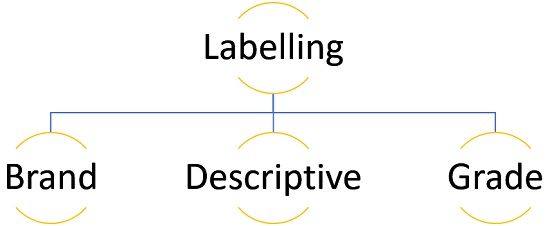Definition: Labelling is a part of branding and enables product identification. It is a printed information that is bonded to the product for recognition and provides detailed information about the product. Customers make the decision easily at the point of purchase seeing the labelling of the product.
Labels must comply with the legal obligations. A company’s label needs to adhere to the Competition and Consumer Act 2010. According to The Food and Drug Administration (FDA), packaged and processed food items must have nutritional labelling. The Federal Trade Commission Act (FTC) states that cheating of labels and graphics is an offence and comprise unjust competition.
The Fair Packaging and Labeling Act establishes compulsory labelling conditions, boosts independent packaging standards and grants federal companies to establish packaging regulations in certain industries.
Types of Labelling
There are different types of labels:
- Brand label: It plays an important role in labelling as it gives information about the brand. It can be removable or non-removable.
- Descriptive label: It specifies product usage.
- Grade label: It describes the aspect and features of the product.
Functions of Labelling
The different functions of labelling are as follows:
- Defines the product and its contents: A label is informative about the product’s usage and caution to be taken while using the product. Example, Red Label Natural Care tea mentions five ingredients in its label that provide immunity.
- Recognition of product: Labeling assists in the identification of the product. Example, the brand name of a chocolate will help one choose from the rest of the confectionery items available.
- Assorting of products: It means classification or grading of products according to different categories in the market. Example, shampoos are categorized as dry hair, normal hair and oily hair types and cater to consumers in the market with the dry, normal and oily scalp, respectively.
- Assists promotion of products: It gives the customer the reason to purchase the product. Example, it attracts the attention of the consumer by displaying messages such as ‘20% free’ or ‘save rupees 15’ message in potato chips packet.
- In compliance with the law: Labels should strictly abide by the law. Example, for tobacco, the label should mention ‘Tobacco is injurious to health’. Cigarettes also should have ‘Smoking is injurious to health’ as the statutory warning on its package.
Importance of labelling
- Labelling is significant as it fetches customers’ attention to purchase the product because of visual appeal.
- It promotes the sale of the product as it can make or break the sale of a product.
Labelling is an important factor in the sale of a product. It helps in grading and provides information required by the law.


victor says
Short but very precise and educative. It also enables one to understand what labelling is all about. It helps to give proper insight to the topic.
Gift says
WOW NICE ONE BEST EVER
Tuyizera David says
It’s educative
Rity Victor says
Full knowledge of this.
Sasi says says
Simply and easy answer gain for more information.
David Williams says
Accurately delivered the concept and was widely understandable.